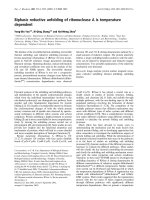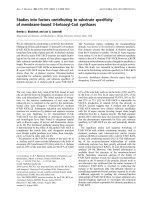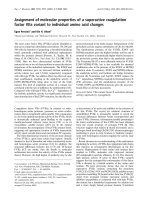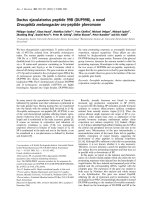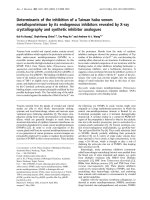Báo cáo y học: "Knowing who would respond to a recruitment maneuver before actually doing it - this might be a way to go." docx
Bạn đang xem bản rút gọn của tài liệu. Xem và tải ngay bản đầy đủ của tài liệu tại đây (37.34 KB, 2 trang )
Page 1 of 2
(page number not for citation purposes)
Available online />Abstract
Using recruitment manoeuvres in acute lung injury remains a
controversial issue because no convincing outcome data support
their general use, although many physiological studies have
demonstrated beneficial effects on lung compliance, end-expiratory
lung volume and gas exchange. One of the reasons why
physiologically meaningful observations do not translate into clear
clinical benefit could be the heterogeneity of the studied patient
population. In patients with consolidated lungs and only limited
potential for recruitment, manoeuvres might be harmful, whereas in
patients with high potential for recruitment they might be helpful.
However, when those populations are mixed any signal may be lost
because of counteracting effects, depending on how the patient
population was mixed. We do not currently have any simple tool
that may readily be applied at the bedside to assess the
recruitment potential in an individual patient, which would be a sine
qua non for identifying a homogeneous population in a recruitment
study. Therefore, the method presented by Jacob Koefeld-Nielsen
and colleagues in the previous issue of Critical Care provides us
with a simple method that could be used at the bedside to assess
recruitment potential before the manoeuvre is applied.
In the previous issue of Critical Care, Koefeld-Nielsen and
colleagues [1] provide us with interesting experimental data
regarding the question of how to predict response to a
recruitment manoeuvre before applying it. They conducted an
animal study (lavage-induced experimental lung injury) to test
the hypothesis that parameters derived from the pressure-
volume (PV) loop recorded before application of the lung
recruitment manoeuvre (LRM) predict the effects of the LRM
on gas exchange, respiratory system compliance (Crs) and
changes in end-expiratory lung volume (EELV). The parameter
derived from the PV loop was the maximal volume difference
between the inspiratory and the expiratory limbs of the PV
loop at a given pressure, indicating the maximal hysteresis
area. This was expressed as a ratio of the total lung capacity,
measured as the volume gained on the PV loop at 4 kPa
airway pressure. Furthermore, they hypothesized that the
volume difference between the inspiratory and expiratory
limbs of the PV curve at a given pressure would correspond
to the change in EELV after the LRM at the same pressure.
Both hypotheses were validated in their well controlled
experimental study design. Specifically, a maximal hysteresis/
total lung capacity ratio of 0.3 predicted improvement in Crs,
EELV and gas exchange after the LRM.
This easily applicable method provides a means to predict the
potential for recruitment, which is of paramount importance to
recruitment strategies in acute lung injury [2]. However, we
do not have any convincing evidence that recruitment
strategies improve clinical outcomes of patients with acute
lung injury (ALI)/acute respiratory distress syndrome (ARDS)
[3-5], although many physiological studies could demonstrate
a recruitment-induced increase in Crs, EELV and gas
exchange (see [3,6]). Recruitment of lung volume is critical in
ALI/ARDS, in which loss of aerated lung volume is an
important pathophysiological factor that leads to intra-
pulmonary shunting of blood, culminating in severe
hypoxaemia [7]. Consequently, the effect of recruitment in the
clinical setting is mostly assessed by determining the effect
on gas exchange. However, computed tomography (CT)
studies [5,8] indicate that dissociation between mechanical
effects and the gas exchange effect of LRM can occur,
rendering gas exchange a rather insensitive parameter with
which to assess LRM. The reason for this dissociation is that
gas exchange only improves when ventilation/perfusion ratios
are affected concomitantly; specifically, ventilation must
improve and perfusion must not diminish. However, because
LRM might also have effects on the perfusion site, gas
exchange merely reflects the functional effect of recruitment,
Commentary
Knowing who would respond to a recruitment maneuver before
actually doing it - this might be a way to go
Ralf Kuhlen
HELIOS Hospital Berlin Buch, Teaching Hospital of the Charite, University Berlin, Schwanebecker Chaussee 50 - 13125 Berlin, Germany
Corresponding author: Ralf Kuhlen,
Published: 31 March 2008 Critical Care 2008, 12:125 (doi:10.1186/cc6834)
This article is online at />© 2008 BioMed Central Ltd
See related research by Koefeld-Nielsen et al., />ALI = acute lung injury; ARDS = acute respiratory distress syndrome; EELV = end-expiratory lung volume; Crs = respiratory system compliance; CT =
computed tomography; LRM = lung recruitment manoeuvre; PV = pressure-volume.
Page 2 of 2
(page number not for citation purposes)
Critical Care Vol 12 No 2 Kuhlen
whereas lung mechanics or CT analysis might reflect
anatomical changes brought about by the LRM [5]. CT
analysis may therefore be helpful in identifying the potential
for recruitment as well as for assessing anatomical effects on
lung ventilation. However, clinically, it is not practical to
conduct repeated CT analyses in patients with severe ARDS
patients in order to optimize the ventilator settings or guide a
recruitment strategy.
Hence, the observation that routine, detailed analysis of a
single PV loop might be helpful in predicting the anatomical
effect of a LRM is of great interest. It is consistent with the
finding that analysis of lung mechanics might be more
accurate than gas exchange in assessing the effect of LRM
[8,9], insofar as it emphasizes the effect on respiratory
mechanical behaviour rather than functional results. It is
important to appreciate this because many studies were
required to teach us that achievement of optimal gas
exchange is not necessarily associated with the best
outcomes in patients.
How could the information provided by Koefeld-Nielsen and
colleagues [1] be used clinically? Their method could be
used as a diagnostic tool to determine potential for
recruitment in individual patients, who could then be stratified
as possible responders or nonresponders in a clinical study
of a recruitment strategy that applies only to responders. This
makes perfect sense because it is reasonable to assume that
any potential evidence in favour of a recruitment strategy in
ALI/ARDS, in terms of clinical outcomes, will only be found if
responders are subjected to the manoeuvre. We would be
able to enter into a strategy of testing ALI/ARDS therapies
tailored to individual pathophysiological observations, rather
then just randomizing large groups of patients who share only
a rather unspecific diagnosis, namely ALI/ARDS as defined
by gas exchange and radiographical criteria. I am absolutely
convinced that this is the way to go for future studies in our
field. Before doing so, however, the experimental observation
made by Koefeld-Nielsen and colleagues [1] must be
assessed clinically. Clinical conditions might weaken a signal
that may be obvious in experimental settings. If the method
presented proves to be sufficiently robust to reflect the effect
of LRMs before they are actually applied, then this could be
the basis for a larger clinical trial, in which it is used as a
diagnostic tool to stratify patients before randomization. I look
forward to seeing this work followed; I consider it the way to
go.
Competing interests
The author declares that they have no competing interests.
References
1. Koefoed-Nielsen J, Nielsen ND, Kjaergaard AJ, Larsson A: Alveo-
lar recruitme nt can be predicted from airway pressure-lung
volume loops: an experimental study in a porcine acute lung
injury model. Crit Care 2008, 12:R7.
2. Slutsky AS, Hudson LD: PEEP or no PEEP: lung recruitment
may be the solution. N Engl J Med 2006, 354:1839-1841.
3. Meade MO, Cook DJ, Guyatt GH, Slutsky AS, Arabi YM, Cooper
DJ, Davies AR, Hand LE, Zhou Q, Thabane L, Austin P, Lapinsky
S, Baxter A, Russell J, Skrobik Y, Ronco JJ, Stewart TE: Ventila-
tion strategy using low tidal volumes, recruitment maneuvers,
and high positive end-expiratory pressure for acute lung
injury and acute respiratory distress syndrome: a randomized
controlled trial. JAMA 2008, 299:637-645.
4. Mercat A, Richard JC, Vielle B, Jaber S, Osman D, Diehl JL,
Lefrant JY, Prat G, Richecoeur J, Nieszkowska A, Gervais C,
Baudot J, Bouadma L, Brochard L: Positive end-expiratory pres-
sure setting in adults with acute lung injury and acute respira-
tory distress syndrome: a randomized controlled trial. JAMA
2008, 299:646-655.
5. Gattinoni L, Caironi P, Cressoni M, Chiumello D, Ranieri VM,
Quintel M, Russo S, Patroniti N, Cornejo R, Bugedo G: Lung
recruitment in patients with the acute respiratory distress
syndrome. N Engl J Med 2006, 354:1775-1786.
6. Lapinsky SE, Mehta S: Bench-to-bedside review: recruitment
and recruiting maneuvers. Crit Care 2005, 9:60-65.
7. Ware LB, Matthay MA: The acute respiratory distress syn-
drome. N Engl J Med 2000, 342:1334-1349.
8. Henzler D, Hochhausen N, Dembinski R, Orfao S, Rossaint R,
Kuhlen R: Parameters derived from the pulmonary pressure
volume curve, but not the pressure time curve, indicate
recruitment in experimental lung injury. Anesth Analg 2007,
105:1072-1078.
9. Grasso S, Terragni P, Mascia L, Fanelli V, Quintel M, Herrmann P,
Hedenstierna G, Slutsky AS, Ranieri VM: Airway pressure-time
curve profile (stress index) detects tidal recruitment/hyperin-
flation in experimental acute lung injury. Crit Care Med 2004,
32:1018-1027.


